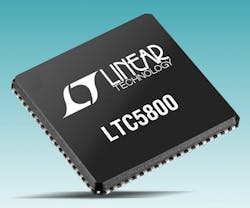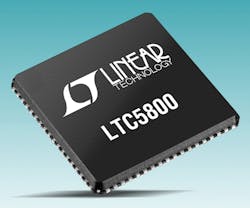Electronic sensors are everywhere, monitoring and controlling temperature, power, fluid levels, and other variables. Integrated-circuit (IC) sensors continue to be made smaller and less expensive, but the cost of installing such sensors with wires is still high. For that reason, using sensors as part of a wireless sensor network (WSN) makes a great deal of sense, especially when such a WSN installation can be established with the highest reliability.
In support of WSN applications, the Dust Networks® product group of Linear Technology Corp. has announced its SmartMesh® WirelessHART™ LTC5800-WHM WSN system-on-chip (SoC) wireless sensor device and its LPT5903-WHR network manager, all based on the IEEE 802.15.4 wireless standard. In spite of the extremely low current consumption (typically less than 50 μA average) for each SoC, these devices and modules combine for highly reliable wireless data exchanges for monitoring and control with minimal interference. They use direct-sequence-spread-spectrum (DSSS) and channel-hopping communications techniques from 2.4000 to 2.4835 GHz.
The SoCs and modules employ the SmartMesh™ wireless sensor technology developed by Dust Networks, a company acquired by Linear Technology in December 2011. A SmartMesh WSN is formed of nodes, or “motes,” which gather and relay data (such as fluid levels in a gas or oil tank), and a network manager. The latter monitors and manages the data from the motes and sends it to a host application, such as a vehicular controller in an automobile. A SmartMesh network makes use of time, frequency, and spatial diversity techniques to achieve flexibility and ease of use with the lowest power consumption possible. This enables the motes to operate for years on batteries, or even on harvested energy.
An LTC5800-WHM is actually a WSN mote within an SoC. Each LTC5800-WHM incorporates WSN capability based on Dust Networks’ Eterna™ IEEE 802.15.4e-compliant SoC technology in a compact 72-pin 10 x 10 mm QFN package (see figure). The IEEE 802.15.4 standard defines a physical layer (PHY) and medium access control (MAC) layer for short-range, low-power operation at low data rates (to 250 kb/s) and small packets (less than 128 bytes). Each SoC contains full wireless radio components, requiring only a decoupling capacitor and connection to an antenna to become part of a WSN. The LTC5800-WHM features single-ended transmit and receive paths, which allows direct connection to a single-ended 50-Ω antenna. The SoC is powered by a single pin connection and has two on-chip DC/DC converters to generate on-chip supplies and conserve energy use. It can be used within line-powered, battery-powered, or energy-harvested applications.
The LTC5800-WHM SoC is designed for use in low-power wireless sensor networks at 2.4 GHz.
To conserve power while ensuring reliable network communications, these devices incorporate the aforementioned SmartMesh technology. Within a WSN, every mote (such as the LTC5800-WHM SoC) works like a router, and can run for as long as 10 years on a battery supply or draw power by means of harvesting. The WSN formed with these devices is a self-forming, self-healing mesh that uses path diversity and per transmission channel hopping for high reliability; the manufacturer states 99.999% data reliability even in harsh RF environments. These SmartMesh motes are controlled and coordinated for efficient channel hopping, using multiple transmissions to optimize available bandwidth. The devices operate by means of a time-synchronized mesh protocol (TSMP) compatible with the IEEE 802.15.4 standard. It works by dividing time into slots and providing a mechanism to map timeslots to channels with a pre-assigned hopping sequence.
The LTC5800-WHM SoC has a recommended supply range of +2.1 to +3.76 VDC. It operates across a frequency range of 2.4000 to 2.4835 GHz using 15 channels and 5-MHz channel separation. The SoC provides a raw data rate of 250 kb/s. It can handle RF input levels as high as +10 dBm and operates with antennas representing a mismatch of a VSWR as high as 3.0:1. With an on-board power amplifier, the LTC5800-WHM has a +8-dBm conducted RF output power and a receiver with typical sensitivity of -93 dBm and typical RSSI range of -10 to -90 dBm. The LTC5800-WHM has a typical indoor range of 100 m and typical outdoor range of 300 m.
The SoC has an operating temperature range of -40 to +85°C. The LTC5800-WHM can be integrated directly onto a customer’s printed-circuit board (PCB), and is also available in two FCC-certified modules: the LTP5901-WHM PCBA module (which measures 42 x 24 mm with an on-board chip antenna), and LTP5902-WHM PCBA module (which is 37.5 x 24 mm with an MMCX antenna connector for use with an external antenna). All work with an LTP5903-WHR SmartMesh WirelessHART manager.
Linear Technology Corp., 1530 McCarthy Blvd., Milpitas, CA 95035-7417; (800) 4-LINEAR, (408) 432-1900, www.linear.com.
About the Author
Jack Browne
Technical Contributor
Jack Browne, Technical Contributor, has worked in technical publishing for over 30 years. He managed the content and production of three technical journals while at the American Institute of Physics, including Medical Physics and the Journal of Vacuum Science & Technology. He has been a Publisher and Editor for Penton Media, started the firm’s Wireless Symposium & Exhibition trade show in 1993, and currently serves as Technical Contributor for that company's Microwaves & RF magazine. Browne, who holds a BS in Mathematics from City College of New York and BA degrees in English and Philosophy from Fordham University, is a member of the IEEE.

